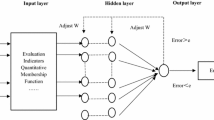Abstract
The evaluation of corporate social responsibility (CSR) performance may enhance companies’ willingness to undertake social responsibilities, so it is very important to improve the quality of CSR performance evaluation. Based on the three factors of economic performance, social performance and environmental performance, this paper proposed an improved analytic hierarchy process-back propagation (AHP-BP) neural network algorithm, and introduced the improved AHP-BP neural network algorithm into CSR performance evaluation model. In the stage of improved AHP, the model included the importance of the knowledge and experience of the experts by expert scoring, and reduced the subjective influence of expert judgment on the results by introducing a personality test scale. In the stage of BP neural network, trained models have been used for CSR performance evaluation. The results showed that the prediction result of improved AHP-BP neural network model was better than that of BP neural network model. Therefore, the improved AHP-BP neural network algorithm can be used as a good predictor for CSR performance evaluation.




Similar content being viewed by others
Explore related subjects
Discover the latest articles, news and stories from top researchers in related subjects.References
Sheldon, O. (1923). The philosophy of management. London: Sir I. Pitman.
Jones, T. M., & Wicks, A. C. (1999). Convergent stakeholder theory. Academy of Management Review,24(2), 206–221.
Donaldson, T., & Dunfee, T. W. (1999). Ties that bind: A social contracts approach to business ethics. Ethics,13(4), 109–110.
Shuzheng, Yang., & Weigang, Xu. (2003). An empirical study of the listed companies’ financial early warning model—y-Score model. China Soft Science,1, 56–60.
Pendharkar, P. C. (2008). A threshold varying bisection method for cost sensitive learning in neural networks. Expert Systems with Applications,34(2), 1456–1464.
Back, B., Laitinen, T., & Sere, K. (1996). Neural networks and genetic algorithms for bankruptcy predictions. Expert Systems with Applications,11(4), 407–413.
Yang, Z. R., Platt, M. B., & Platt, H. D. (1999). Probabilistic neural networks in bankruptcy prediction. Journal of Business Research,44(2), 67–74.
Zhang, G., Hu, M. Y., Patuwo, B. E., & Indro, D. C. (1999). Artificial neural networks in bankruptcy prediction: General framework and cross-validation analysis. European Journal of Operational Research,116(1), 16–32.
Saaty, (1980). The analytic hierarchy process. New York: McGraw-Hill.
Huang, G., Sun, S., & Zhang, D. (2018). Safety evaluation of construction based on the improved ahp-grey model. Wireless Personal Communications, 103(1), 1–11.
Fu, J., & Zhang, L. (2012). Green marketing performance evaluation of circular economy based on AHP and BP neural network model. Science and Technology Management Research, 20, 222–227.
Hailin, Wang. (2017). Research on the identification and diagnosis of internal control defects in enterprises—Model construction based on neural network. Accounting Research,8, 74–80.
Rumelhart, D. E., Hinton, G. E., & Williams, R. J. (1988). Learning internal representation by error propagation. Neurocomputing: Foundations of research. Cambridge: MIT Press.
Bailer-Jones, C. A. L., Gupta, R., Singh, H. P., & Bulsari, A. B. (2001). An introduction to artificial neural networks. Neural Networks for Chemical Engineers,19(12), 36–62.
Mao, Z. (2009). Ann-based metallogenic prognosis model. Metal Mine,2009(7), 66–68.
Shinde, D. D., & Prasad, R. (2017). Application of ahp for ranking of total productive maintenance pillars. Wireless Personal Communications,7, 1–14.
Zhiqiang, Liang., & Dansheng, Lin. (2017). Research on information security risk assessment mechanism based on power system. Information Network Security,4, 86–90.
Wei, Wang. (2011). Network security assessment of AHP and SVM combination. Computer Simulation,28(3), 182–185.
Wang, X., Liang, D., Song, W., & Zhou, Y. (2018). Distributed intelligent pension system based on bp neural network. Wireless Personal Communications,1–10, 1–12.
Chen, S. (2002). Effects of personality traits on information processing in different cognitive tasks. Doctoral dissertation, South China Normal University.
Digman, J. M. (1990). Personality structure: Emergence of the 5 factor model. Annual Review of Psychology,41(1), 417–440.
Shaohua, Chen., & Xue, Zheng. (2001). On the behavioral genetic orientation of individual psychological differences. Journal of South China Normal University,2, 31–35.
Costa, P. T., & Mccrae, R. R. (1988). From catalog to classification: Murray’s needs and the five-factor model. Journal of Personality and Social Psychology,55(2), 258–265.
Li, Y. (2013). Blue book on corporate social responsibility—China Corporate social responsibility research report (2013). Social Sciences Literature Press.
Huang, Q., et al. (2017). Blue book on corporate social responsibility—China Corporate social responsibility research report (2017). Social Sciences Literature Press.
Zhong, M., Xu, R., Liao, X., & Zhang, S. (2019). Do CSR Ratings Converge in China? A Comparison Between RKS and Hexun Scores. Sustainability, 11(14), 3921.
Elkington, J. (1998). Cannibals with forks: The triple bottom line of sustainability (pp. 37–51). Gabriola: New Society Publishers.
Freeman, R. E., & Reed, D. L. (1983). Stockholders and stakeholders: A new perspective on corporate governance. California Management Review,25(3), 88–106.
Popoola, S., Misra, S., & Atayero, A. (2017). Outdoor path loss predictions based on extreme learning machine. Wireless Personal Communications,99, 441–460.
Li, J. (2009). Listed company financial risk early warning based on data mining. Doctoral dissertation, Xi’an University of Science and Technology.
Acknowledgements
This work was supported by the Project of the National Natural Science Foundation of China (Grant No. 71472088). Special thanks should be given to the authors of references. Any errors or shortcoming in the paper are the responsibility of the authors.
Author information
Authors and Affiliations
Corresponding author
Additional information
Publisher's Note
Springer Nature remains neutral with regard to jurisdictional claims in published maps and institutional affiliations.
Rights and permissions
About this article
Cite this article
Li, W., Xu, G., Xing, Q. et al. Application of Improved AHP-BP Neural Network in CSR Performance Evaluation Model. Wireless Pers Commun 111, 2215–2230 (2020). https://doi.org/10.1007/s11277-019-06981-z
Published:
Issue Date:
DOI: https://doi.org/10.1007/s11277-019-06981-z





